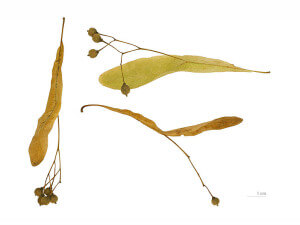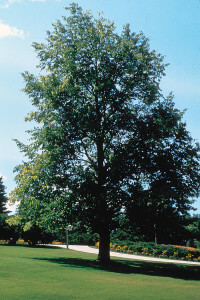American Linden (Tilia americana) – 40 seeds
Little Leaf Linden (Tilia cordata) – 40 seeds

The American Linden Tree (Tilia americana) is a New England Native Tree that also goes by the name Basswood Tree.
This article also applies to many other plants in this genus, notably the European species Little Leaf Linden (Tilia cordata) and Large leaved Linden (Tilia platyphylos) and the Asian species Japanese Lime Tree (Tilia japonica) and Chinese Lime Tree (Tilia chinensis). Outside of the US these trees are often called Lime Trees though not closely related the actual Lime Trees which are in the genus: Citrus. Linden trees are commonly planted as street trees and wind breaks because of their uniform shape and leaf density. The elongated leafy bract attached to the flowers and berries is the best way to identify a Linden Tree (see picture below), alternatively the uniform shape of smaller trees and the heart-shaped finely serrated leaves will also help in identification.
Edibility and Culinary Use

The leaves of this plant are edible all spring, summer and fall. They taste like lettuce but have a mucilaginous texture, young leaves are the most tender but older leaves are still good to eat. They make a great lettuce substitute in salads or sandwiches. Lindens are medium to large trees so there is no shortage of edible leaves. There are not a lot of large trees that have edible leaves without toxins, a bad flavor or a tough texture. Linden flowers can be eaten raw but more commonly are made into a linden flower tea, they are also a very popular flower for honey bees. Linden tree honey has a distinct flavor that makes the honey more desirable. Linden fruits can be eaten at different stages of growth, but they are small and hard with little or no flavor.
Health Benefits

The flowers and probably also the leaves of the linden tree contain Flavonoids which are antioxidants. Linden tea has commonly been used for cold, cough, and soar throats. It is said to be generally calming and an effective sleep aid. The nutritional value of Linden leaves has not been thoroughly studied, this is another wild edible whos nutritional benefits are still relatively unknown.
Cautions
Very few people have experienced contact dermatitis from linden tea. If the flowers are too old when making linden tea it may have a slight narcotic effect.
Conclusion

The linden tree is an abundant source of edible leaves. I always wonder why our culture has gotten in the habit of planting annuals such as lettuce and spinach every year when we could plant one linden tree that would produce food for a lifetime.
Many of our readers find that subscribing to Eat The Planet is the best way to make sure they don't miss any of our valuable information about wild edibles.
See our privacy policy for more information about ads on this site







9 Responses
yes-i thought this often-why plant lettuce when cool shady linden or slippery elm trees give so much-for no work-no plow,no seeding-protects s n feeds the soil.n.adds water to the air for rain,etc etc-,etc-plus linden leaves can be stored all winter-try that with lettuce-lol-here in pubnico they started big smelly tidal organics seaweed plant-to provide for various buyers who need the slimy protein of linden leaves wd be better-not polluted like the seawwed fr the worlds toilet bowl,the sea–why eat lobster or other insects feeding on toilet bowl scum on bottom of sea-so,they cd use linden instead-less processing to do,less pollution n plant workers health damage n hazards-big thanx–now i ll read the spruce note u wrote-lots spruce here-
ya it seems obvious to me that they should switch to more perennial farming in many cases. this is one of those perfect examples.
Awesome information …. I have one of these growing in my yard.
My tree is large, and an awful lot of berries cover my deck. I dont remember a year when there were so many berries. I am not fond of walking on them. Is there a way to reduce number of seeds?
Need to reduce number of seeds coveringmy deck!
Sweep 🧹 them into a large salad bowl 🥣 and crack each seed, throw away the shells and enjoy throwing the meat of the seeds into a salad 🥗 😉
Just today I tried eating dry linden seeds in the shell right off a tree and found it delightful. They resembled sunflower seeds or peanuts in the shell. I didn’t mind eating the shell and all. I imagine roasted and salted, they’d be a real “tree-at”.
I plan on trying this next year!: https://foragerchef.com/linden-chocolate/
I have one in my front yard. Right now it is bidding and I’m experimenting with the buds from eating them raw to throwing them in my last minute of cooking for a stirfry 🙂
I had some large linden logs cut into boards, and used them to make sauna benches. The are a wonderful butter yellow, and work great for this purpose. All sauna benches need to be softwood, because hardwoods heat up too much. I aged the wood about 7 years in the basement.